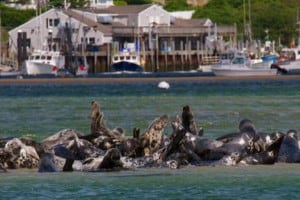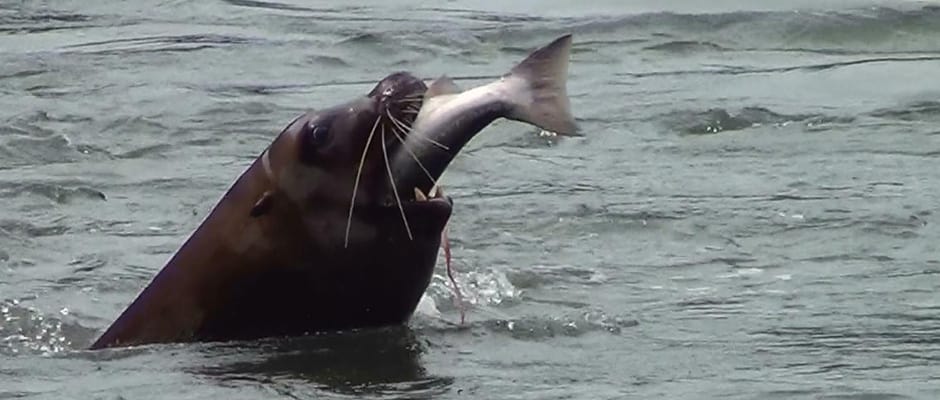Share this article
Predator Recovery Creates New Management Challenges
Conservationists often struggle to institute affordable wildlife recovery plans that actually work, fully aware that success stories aren’t always the rule.
But a new study published in Conservation Letters shows that sometimes ecosystems — and society — aren’t always ready for what happens when wildlife populations, particularly predator species, rebound.

The restoration of formerly endangered species is raising conflict in some places such as coastal Massachusetts where gray seals have returned. Here, gray seals bicker at a sandy haulout in Chatham Harbor, Cape Cod during the summer of 2013. A new study by scientists at the University of Vermont and Duke University explores strategies to better manage and celebrate the recovery of these animals.
Image Credit: David W. Johnston under permit by NOAA
“Predators such as bears, wolves and whales are charismatic creatures often seen as bellwethers of ecosystem health,” said Kristin Marshall in a release. Marshall is a postdoctoral researcher at the National Marine Fisheries Service of the National Oceanic and Atmospheric Administration who completed graduate research in Yellowstone National Park and the lead author of the recent study. “We’re fortunate to have places such as Yellowstone and the Northeast Pacific where they can recover, but in protecting one species you have to be thinking ahead to account for cascading effects that may impact other species too.”
When predators are extirpated, or become severely limited in some populations, there are a number of direct and indirect effects on the resulting ecosystems. The species wolves tend to prey on like elk (Cervus canadensis), for example, can surge in their absence. If the wolves are gone for a long time, the increased number of herbivorous grazers can have other effects on the plant life in an area.
But fixing this problem isn’t always as easy as plugging the missing hole since other changes like climate may have effects on ecosystems. Gray wolves (Canis lupus) were extirpated from the Yellowstone for 70 years, for example, and while they’re starting to come back, the game might have changed.
“When you get out on the ground and start measuring things it gets a lot cloudier,” Marshall said in terms of telling whether an ecosystem has recovered due to successful reintroduction.
“These single species approaches when thinking about predators is potentially limiting when what we’re really trying to do is recover and maintain whole ecosystem,” she said.
In the study, Marshall and others compared populations of land and sea predators like wolves and grizzly bears (Ursus arctos ssp.) in Yellowstone and sea lions in the Pacific Northwest.
She believes that looking at things on a larger level would help wildlife managers make better reintroduction plans or conservation strategies.
“The approaches that we discuss, like risk assessment and ecosystems monitoring, would allow you to figure out the state of relationships in any system you’re working in,” she said.
This whole system approach could also help ecologists understand why some species recovery plans aren’t successful. In the case of the Yellowstone, wildlife managers still don’t know how recovering wolf and grizzly populations will interact, for example.
Dealing With a Hostile Reaction
Another separate study recently looked at when the recovery of large predators can meet with a hostile reaction from humans living in those areas as the animals compete for some of the same fishing or recreational resources.
“When native species return, it can be a struggle for communities,” said Joe Roman of the University of Vermont’s Gund Institute for Ecological Economics and the lead author of the study published in Trends in Ecology and Evolution. “After generations away, these forgotten species can suddenly be seen as newcomers — or even pests
North Atlantic gray seals (Halichoerus grypus) have been blamed for everything from disappearing fish stocks in Massachusetts to the increase in sharks around the Cape Cod area. Roman said “wildlife managers need to do a better job of planning for the return of these species to avoid future conflicts.”
The authors of that paper recommend planning ahead with potential stakeholders for impacts and adaptation, celebrating conservation success with the public, making better policies for dealing with “nuisance animal” killings and delisting species that no longer need protection.
Marshall, whose study also looked at some of the conflicts predators create with humans after recovery, said that Roman provided a good perspective.
“We’re suggesting that it might be a good idea to take a broader view,” she said of the approach her study took to dealing with these reintroduction conflicts.
“In some cases there might be win-win scenarios; in other cases there might not be.”
Header Image:
A Steller sea lion eating a chinook salmon at Bonneville Dam on the Columbia River. They prey on salmon and steelhead, many of them endangered, as the fish enter fish ladders to swim upstream. Authors of a recent study found that sometimes the recovery of predators can cause new problems to ecosystems and society.
Image Credit: U.S. Army Corps of Engineers








